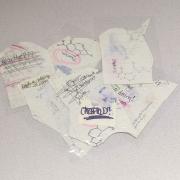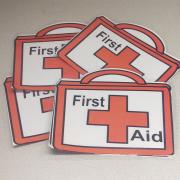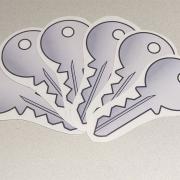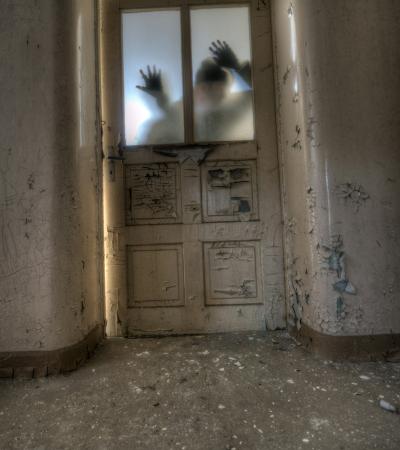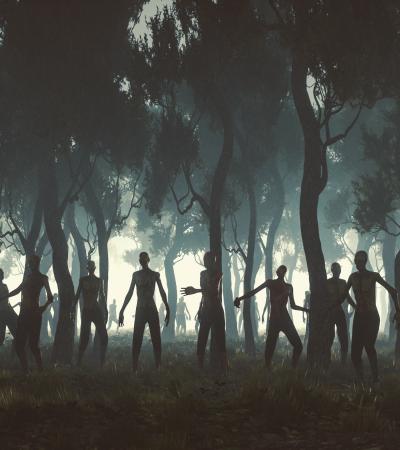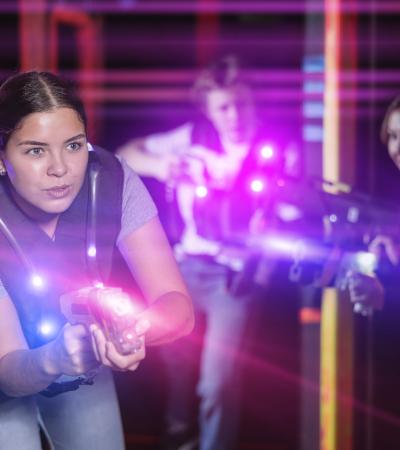Imagine our surprise when we found out a rogue scientist had set up a lab right here in the library ... and, you guessed it, things have gone awry. The tests have gotten out of control, and we’re now overrun with zombies!
In this fun after-hours program, young adult patrons came to the library ready to battle the hordes. Their challenge: use their smarts to decode clues ... or become one of the infected.
Advanced Planning
The goal of this program was to bring in new patrons and introduce them to the services offered and locations of materials through a creative and interactive game. I began planning a few months in advance so I would be able to decide which areas and services to highlight and have ample time to write clues that led the participants to said services and areas.
An example clue: "Alohomora unlocks a door; need one more? Look in Book 4,” with a key hidden in the fourth novel in the "Harry Potter" series. (View more clues under Attachments at right).
I also worked in advance to create player rules and a back story for all participants; to print and laminate the program clues; and to purchase supplies.
I made the following in advance. I used stock images and clip art for many of the printed images.
- Zombie brain necklaces: Print an image of a brain, laminate, then clip to ribbon/string/yarn to serve as a necklace.
- Cleaner badges: Print a police (or other official-looking) badge onto a label sheet.
- Zombie bite stickers: Print small, sticker-sized pictures of a zombie, then laminate and tape to badges; or print as stickers on label sheets and apply to badges.
- Revived stickers: Print labels or stickers that say "revived" or just apply pieces of colored tape to revived players' badges.
- Antidote pieces: Create handwritten scrambled notes, then cut into puzzle pieces and laminate. Seal all puzzle pieces into an envelope.
- First-aid kit: Print an image of a first-aid kit, then laminate.
- Keys: Print an image of a basic key, then laminate.
- Clues: Create riddles or clues that highlight a certain area of the library or service offered. These can be broad or specific, depending on your age group and the time available. (View images of sample game pieces under Photo Slideshow at right.)
Marketing
We advertised for the program in a quarterly newsletter as well as through a calendar on our website.
Budgeting
This can be a very low-budget or potentially free program, with very few purchased items needed. I like to create programs that allow for a DIY aspect, as they work for small budgets but can also be ramped up with fancier, purchased supplies should budget allow.
In total, I bought eight single dart shot Nerf guns for $5 each ($40 total) and 30 extra darts for $7, bringing my total budget to under $50.
See the Advance Planning section for a list of materials I created with supplies the library already had on hand.
Day-of-event Activity
Our day-of-event to-do list was as follows:
- Set up the location of the team “bases” (two, one for each of our two teams of humans) and the “armory” (our staff desk).
- Hide the clues and puzzle piece envelopes in the game area.
- Print out individual player directions, tasks and rules.
- If possible, do a dry run with staff earlier in the day or a few days before.
Program Execution
This was an after-hours program, so we let participants know that the doors would be locked and the event would begin at 6 p.m., when the library closed. We stressed that attendees must arrive before 6 p.m. and instructed them to meet us in a conference room to take attendance and go over team assignments and game rules.
Once the library closed, two staff members stayed upstairs in the teen/children's area to hide the clues, keys and puzzle pieces for teams to find. These staff members set up the two bases and placed four of the Nerf guns with darts and one first-aid kit in each, and also set up extra supplies/materials at the armory.
Two staff members gathered attendees in the meeting room and created two human teams of nine players each — with one player on each team assigned the role of “scientist” — and one zombie team of 18 players. These staff members then went over the general rules of the game in addition to passing out player-specific instructions and going over details and how to win the game. (View a more thorough overview of the game under Attachments at right.)
The rules were as follows:
- Zombies occupy the neutral zone. They roam around slowly trying to tag humans while avoiding being shot by Nerf darts.
- Each human team has a home base — two areas on opposite ends of the room — that function as a safe point where zombies may not enter nor tag them.
- The zombie players have brain pictures taped to their badges; they have to give up a brain if they are shot. When they run out, they are out of the game.
- The human players have zombie faces taped to their badges; they have to give up a zombie face if they are tagged. When they run out, they are out of the game.
- Zombie brains can be traded for supplies at the armory (see below).
- Human teams may enter one another’s bases for safety, but they may not use their scientists.
- Each human team starts with four Nerf guns and one first-aid kit.
- Each human team gets one "scientist" player who must stay in the base at all times. They are the only players who can open and read the clues.
- Each human team can work on either mission (see below).
- To revive a "zombified" human teammate, an active human teammate must bring the first-aid kit drawing and the zombified teammate to the armory or base and turn in the first-aid kit.The revived teammate then gets a “revived” sticker.
- Spent darts must be left on the floor! Players cannot pick them up for reuse.
- The armory (staff desk) contains:
- Extra blaster charges (darts); cost is one brain.
- Extra first-aid kids; cost is three brains.
Library staff also explained two ways to end the game:
- Players can collect keys and intel (via the clues) to find and unlock the Fail-Safe Switch, which will shut down the entire lab;
- OR, players can collect intel (via the clues) and supplies in the form of puzzle pieces to create an antidote.
We had 36 teens sign up and attend. Participants' ages varied from younger teens up to seniors in high school, as we accept grades 6 to 12 for general teen programs. We had mostly male attendees but also a handful of females. We expected there would be some chaos (as you should with teens and Nerf guns), but it got a bit more chaotic than we thought and took some extra effort to keep things in line at times. This would have been helped with additional staff/volunteers.
Aside from that, the attendees were enthusiastic and upbeat about the game; they seemed to have quite a lot of fun and even suggested tweaks for future runs of the program, which left us considering an event geared toward older teens where we make it a bit spookier with lights lowered and creepy music.
I would definitely run this program again.
Advice
Have fun!
If it turns out your clues are way too hard (or something about the game isn't working well with your group), fix it or forgo it! The point of this isn't to be strict but to have fun, so don't worry if you need to change the game halfway through. For example, we were having trouble with the two human teams so we said "heck, let's combine teams" and turned it into one human team against one zombie team instead.
We also ran out of time to switch parts for the second game, so we just turned all humans into zombies, and all zombies into humans, then turned them loose with nothing but "basic rules of safety." They had a blast just running around shooting one another.
We had 36 participants, so four Nerf guns per team worked well, but you could have even more. We wanted to try to have one Nerf holder team up with a non-Nerf holder to work in pairs, but whatever fits your group is best!
Supporting Materials
- Feedback (Coming Soon!)
- Programming Librarian Facebook Group


